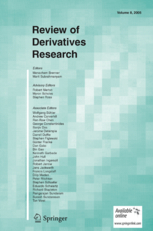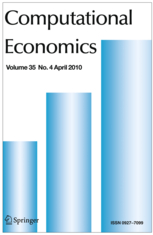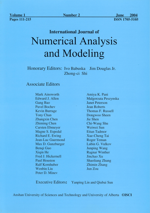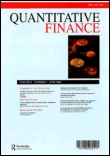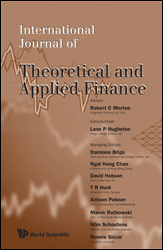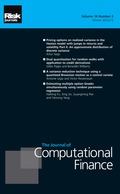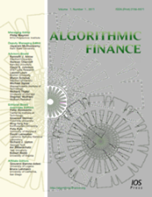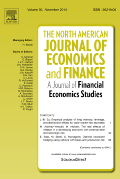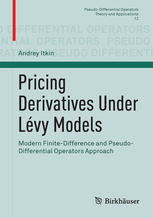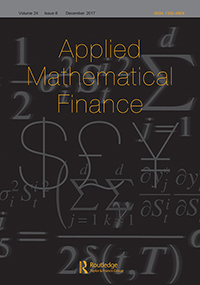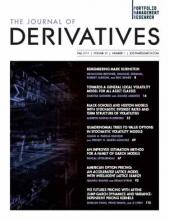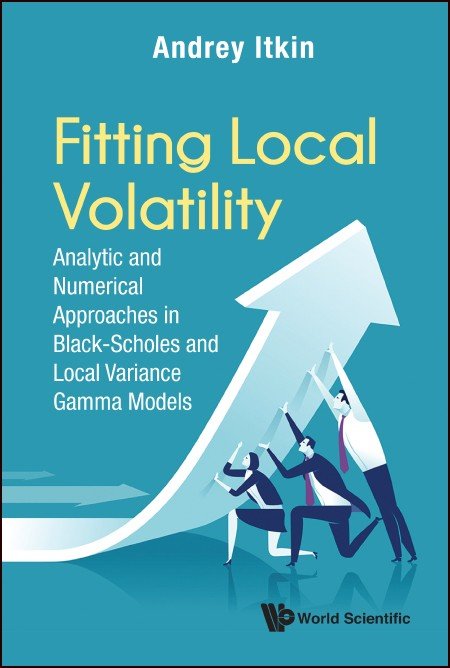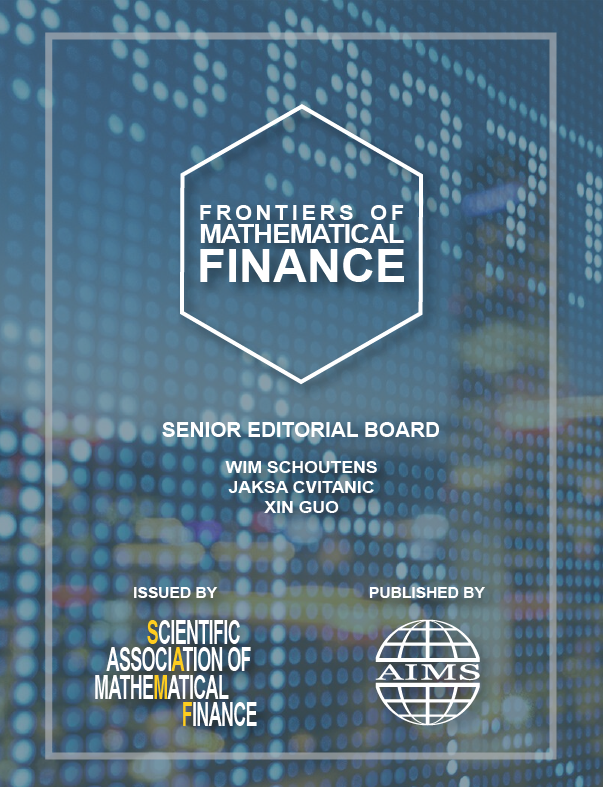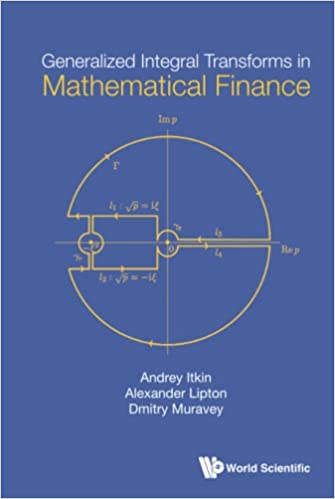N |
Authors |
Title |
Abstract |
Electronic |
Printed |
Text |
|
1 |
A. Itkin |
Pricing options with VG model using FFT |
We discuss various analytic and numerical methods that have been used to get option prices within a framework of the VG model. We show that some popular methods, for instance, Carr-Madan's FFT method could blow up for certain values of the model parameters even for European vanilla option. Alternative methods - one originally proposed by Lewis, and Black-Scholes-wise method are considered that seem to work fine for any value of the VG parameters. Test examples are given to demonstrate efficiency of these methods. Convergence of all methods is also discussed |
Extended version prepared for the VG Conference (see Presentations) |
|
|
|
2 |
A. Itkin, |
Pricing swaps and options on quadratic variation under stochastic time-change models discrete observations case |
We use a forward characteristic function approach to price variance and volatility swaps and options on swaps. The swaps are defined via contingent claims whose payoffs depend on the terminal level of a discretely monitored version of the quadratic variation of some observable reference process. As such a process we consider a class of Levy models with stochastic time change. Our analysis reveals a natural small parameter of the problem which allows a general asymptotic method to be developed in order to obtain a closed-form expression for the fair price of the above products. As examples, we consider the CIR clock change, general affine models of activity rates and the 3/2 power clock change and give an analytical expression of the swap price. Comparison of the results obtained with a familiar log-contract approach is provided. |
|
Review of Derivatives Research, 2010, Vol.13, N.2,, p.141-176. |
|
|
3 |
A. Itkin, |
Using pseudo-parabolic and fractional equations for option pricing in jump diffusion models. |
In mathematical finance a popular approach for pricing options under some Levy model is to consider underlying that follows a Poisson jump diffusion process. As it is well known this results in a partial integro-differential equation (PIDE) that usually does not allow an analytical solution while numerical solution brings some problems. In this paper we elaborate a new approach on how to transform the PIDE to some class of so-called pseudo-parabolic equations which are known in mathematics but are relatively new for mathematical finance. As an example we discuss several jump-diffusion models which Levy measure allows such a transformation. |
Computational
Economics, |
||
|
4 |
A. Itkin, |
Jumps without Tears: A New Splitting Technology for Barrier Options |
The market pricing of OTC FX options displays both stochastic volatility and stochastic skewness in the risk-neutral distribution governing currency returns. To capture this unique phenomenon Carr and Wu developed a model (SSM) with three dynamical state variables. They then used Fourier methods to value simple European-style options. However, pricing exotic options requires numerical solution of 3D unsteady PIDE with mixed derivatives which is expensive. In this paper to achieve this goal we propose a new splitting technique. Being combined with another method of the authors, which uses pseudo-parabolic PDE instead of PIDE, this reduces the original 3D unsteady problem to a set of 1D unsteady PDEs, thus allowing a significant computational speedup. We demonstrate this technique for single and double barrier options priced using the SSM. |
|
International
Journal of Numerical Analysis and Modeling,
|
|
|
5 |
A. Itkin |
New solvable stochastic volatility models for pricing volatility derivatives |
Classical solvable stochastic volatility models (SVM) use a CEV process for instantaneous variance where the CEV parameter $\gamma$ takes just few values: 0 - the Ornstein-Uhlenbeck process, 1/2 - the Heston (or square root) process, 1- GARCH, and 3/2 - the 3/2 model. Some other models were discovered in \cite{Labordere2009} by making connection between stochastic volatility and solvable diffusion processes in quantum mechanics. In particular, he used to build a bridge between solvable (super)potentials (the Natanzon (super)potentials, which allow reduction of a Schr\"{o}dinger equation to a Gauss confluent hypergeometric equation) and existing SVM. In this paper we discuss another approach to extend the class of solvable SVM in terms of hypergeometric functions. Thus obtained new models could be useful for pricing volatility derivatives (variance and volatility swaps, moment swaps). |
Review of
Derivatives Research,
|
|
|
|
6 |
I.
Halperin, |
Pricing options on illiquid assets with liquid proxies using utility indifference and dynamic-static hedging |
This work addresses the problem of optimal pricing and hedging of a European option on an illiquid asset Z using two proxies: a liquid asset S and a liquid European option on another liquid asset Y. We assume that the S-hedge is dynamic while the Y-hedge is static. Using the indifference pricing approach, we derive a HJB equation for the value function, and solve it analytically (in quadratures) using an asymptotic expansion around the limit of the perfect correlation between assets Y and Z. While in this paper we apply our framework to an incomplete market version of the credit-equity Merton's model, the same approach can be used for other asset classes (equity, commodity, FX, etc.), e.g. for pricing and hedging options with illiquid strikes or illiquid exotic options. |
Quantitative Finance,
|
|
|
|
7 |
I.
Halperin, |
Pricing Illiquid Options with N+1 Liquid Proxies Using Mixed Dynamic-Static Hedging |
We study a problem of optimal pricing and hedging of a European option written on an illiquid asset Z using a set of proxies: a liquid asset S, and N liquid European options P_i, each written on a liquid asset Y_i, i=1,N. We assume that the S-hedge is dynamic while the multi-name Y-hedge is static. Using the indifference pricing approach with an exponential utility, we derive a HJB equation for the value function, and build an efficient numerical algorithm. The latter is based on several changes of variables, a splitting scheme, and a set of Fast Gauss Transforms (FGT), which turns out to be more efficient in terms of complexity and lower local space error than a finite-difference method. While in this paper we apply our framework to an incomplete market version of the credit-equity Merton's model, the same approach can be used for other asset classes (equity, commodity, FX, etc.), e.g. for pricing and hedging options with illiquid strikes or illiquid exotic options. |
International Journal of
Theoretical and Applied Finance,
|
|
|
|
8 |
I.
Halperin, |
USLV: Unspanned Stochastic Local Volatility Model |
We propose a new framework for modeling stochastic local volatility, with potential applications to modeling derivatives on interest rates, commodities, credit, equity, FX etc., as well as hybrid derivatives. Our model extends the linearity-generating unspanned volatility term structure model by Carr et al. (2011) by adding a local volatility layer to it. We outline efficient numerical schemes for pricing derivatives in this framework for a four-factor specification (two ``curve'' factors plus two ``volatility'' factors). We show that the dynamics of such a system can be approximated by a Markov chain on a two-dimensional space $(Z_t,Y_t)$, where coordinates $ Z_t $ and $Y_t $ are given by direct (Kronecker) products of values of pairs of curve and volatility factors, respectively. The resulting Markov chain dynamics on such partly ``folded'' state space enables fast pricing by the standard backward induction. Using a nonparametric specification of the Markov chain generator, one can accurately match arbitrary sets of vanilla option quotes with different strikes and maturities. Furthermore, we consider an alternative formulation of the model in terms of an implied time change process. The latter is specified nonparametrically, again enabling accurate calibration to arbitrary sets of vanilla option quotes. |
|
|
|
|
9 |
A. Itkin |
Efficient Solution of Backward Jump-Diffusion PIDEs with Splitting and Matrix Exponentials. |
We propose a new, unified approach to solving jump-diffusion partial integro-differential equations (PIDEs) that often appear in mathematical finance. Our method consists of the following steps. First, a second-order operator splitting on financial processes (diffusion and jumps) is applied to these PIDEs. To solve the diffusion equation, we use standard finite-difference methods, which for multi-dimensional problems could also include splitting on various dimensions. For the jump part, we transform the jump integral into a pseudo-differential operator. Then for various jump models we show how to construct an appropriate first and second order approximation on a grid which supersets the grid that we used for the diffusion part. These approximations make the scheme to be unconditionally stable in time and preserve positivity of the solution which is computed via a matrix exponential. The paper demonstrates that the proposed method is computationally efficient, accurate and simple to implement. |
Journal of Computational
Finance,
|
|
|
|
10 |
A. Itkin |
High-Order Splitting Methods for Forward PDEs and PIDEs |
This paper is dedicated to the construction of high-order (in both space and time) finite-difference schemes for both forward and backward PDEs and PIDEs, such that option prices obtained by solving both the forward and backward equations are consistent. This approach is partly inspired by Andreasen & Huge, 2011 who reported a pair of consistent finite-difference schemes of first-order approximation in time for an uncorrelated local stochastic volatility model. We extend their approach by constructing schemes that are second-order in both space and time and that apply to models with jumps and discrete dividends. Taking correlation into account in our approach is also not an issue. |
International Journal of
Theoretical and Applied Finance,
|
|
|
|
11 |
A. Itkin |
Splitting and Matrix Exponentials approach for jump-diffusion models with Inverse Normal Gaussian, Hyperbolic and Meixner jumps. |
This paper is a further extension of the method proposed in Itkin, 2014 as applied to another set of jump-diffusion models: Inverse Normal Gaussian, Hyperbolic and Meixner. To solve the corresponding PIDEs we accomplish few steps. First, a second-order operator splitting on financial processes (diffusion and jumps) is applied to these PIDEs. To solve the diffusion equation, we use standard finite-difference methods. For the jump part, we transform the jump integral into a pseudo-differential operator and construct its second order approximation on a grid which supersets the grid that we used for the diffusion part. The proposed schemes are unconditionally stable in time and preserve positivity of the solution which is computed either via a matrix exponential, or via P'ade approximation of the matrix exponent. Various numerical experiments are provided to justify these results |
Algorithmic Finance,
|
|
|
|
12 |
A. Itkin |
To sigmoid-based functional description of the volatility smile. |
We propose a new static parameterization of the implied volatility surface which is constructed by using polynomials of sigmoid functions combined with some other terms. This parameterization is flexible enough to fit market implied volatilities which demonstrate smile or skew. An arbitrage-free calibration algorithm is considered that constructs the implied volatility surface as a grid in the strike-expiration space and guarantees a lack of arbitrage at every node of this grid. We also demonstrate how to construct an arbitrage-free interpolation and extrapolation in time, as well as build a local volatility and implied pdf surfaces. Asymptotic behavior of this parameterization is discussed, as well as results on stability of the calibrated parameters are presented. Numerical examples show robustness of the proposed approach in building all these surfaces as well as demonstrate a better quality of the fit as compared with some known models. |
The North
American Journal of Economics and Finance, |
|
|
|
13 |
A. Itkin |
Efficient solution of structural default models with correlated jumps and mutual obligations. |
The structural default model of Lipton and Sepp, 2009 is generalized for a set of banks with mutual interbank liabilities whose assets are driven by correlated Levy processes with idiosyncratic and common components. The multi-dimensional problem is made tractable via a novel computational method, which generalizes the one-dimensional fractional partial differential equation method of Itkin, 2014 to the two- and three-dimensional cases. This method is unconditionally stable and of the second order of approximation in space and time; in addition, for many popular Levy models it has linear complexity in each dimension. Marginal and joint survival probabilities for two and three banks with mutual liabilities are computed. The effects of mutual liabilities are discussed, and numerical examples are given to illustrate these effects. |
International
Journal of Computer Mathematics,
|
|
|
|
14 |
A. Itkin |
Structural default model with muttual obligations. |
This paper considers mutual obligations in the interconnected bank system and analyzes their influence on joint and marginal survival probabilities as well as CDS and FTD prices for the individual banks. To make the role of mutual obligations more transparent, a simple structural default model with banks' assets driven by correlated multidimensional Brownian motion with drift is considered. This model enables a closed form representation for many quantities of interest, at least in a 2D case, to be obtained, and moreover, model calibration is provided. Finally, we demonstrate that mutual obligations have to be taken into account in order to get correct values for model parameters. |
Review of Derivatives
Research |
|
|
|
15 |
A. Itkin |
Nonlinear
PDEs risen when solving some optimization |
We consider a specific type of nonlinear partial differential equations (PDE) that appear in mathematical finance as the result of solving some optimiza tion problems. We review some existing in the literature examples of such problems, and discuss the properties of these PDEs. We also demonstrate how to solve them numerically in a general case, and analytically in some particular case. |
Journal of
Computational Finance
|
|
|
|
16 |
A. Itkin |
LSV models with stochastic interest rates and correlated jumps |
Pricing and hedging exotic options using local stochastic volatility models drew a serious attention within the last decade, and nowadays became almost a standard approach to this problem. In this paper we show how this framework could be extended by adding to the model stochastic interest rates and correlated jumps in all three components. We also propose a new fully implicit modification of the popular Hundsdorfer and Verwer and Modified Craig-Sneyd finite-difference schemes which provides second order approximation in space and time, is unconditionally stable and preserves positivity of the solution, while still has a linear complexity in the number of grid nodes. |
International Journal of
Computer Mathematics,
|
|
|
|
17 |
A. Itkin |
Pricing derivatives under Levy models. Modern finite difference and pseudo-differential operators approach. |
This book was devised with a purpose of presenting a new method, developed in a series of papers, and intended to propose a more efficient numerical approach to solving partial integro-differential equations. The latter appear in mathematical finance if, e.g., one takes into account jumps in the underlying spot price when pricing options written on this underlying. |
|
Springer, 2017, ISBN 978-1-4939-6792-6
|
|
|
18 |
A. Itkin, |
Filling the gaps smoothly |
The calibration of a local volatility models to a given set of option prices is a classical problem of mathematical finance. It was considered in multiple papers where various solutions were proposed. In this paper an extension of the approach proposed in LiptonSepp2011 is developed by i) replacing a piecewise constant local variance construction with a piecewise linear one, and ii) allowing non-zero interest rates and dividend yields. Our approach remains analytically tractable; it combines the Laplace transform in time with an analytical solution of the resulting spatial equations in terms of Kummer's degenerate hypergeometric functions. |
Journal of Computational
Science
|
|
|
|
19 |
A. Itkin |
Modeling stochastic skew of FX options using SLV models with stochastic spot/vol correlation and correlated jumps |
It is known
that the implied volatility skew of FX options demonstrates a
stochastic behavior which is called stochastic skew. In this
paper we create stochastic skew by assuming the
spot/instantaneous variance correlation to be stochastic.
Accordingly, we consider a class of SLV models with stochastic
correlation where all drivers - the spot, instantaneous
variance and their correlation are modeled by Levy processes.
We assume all diffusion components to be fully correlated as
well as all jump components. A new fully implicit splitting
finite-difference scheme is proposed for solving forward PIDE
which is used when calibrating the model to market prices of
the FX options with different strikes and maturities. The
scheme is unconditionally stable, of second order of
approximation in time and space, and achieves a linear
complexity in each spatial direction. The results of
simulation obtained by using this model demonstrate capacity
of the presented approach in modeling stochastic skew |
Applied Mathematical Finance
|
|
|
|
20 |
K. in't
Hout, |
Editorial |
Special Issue - Computational methods in Finance |
|
International Journal of
Computer Mathematics,
|
|
|
21 |
K. in't
Hout, |
Editorial |
Special Issue - Computational and algorithmic finance |
|
Computational Science,
|
|
|
22 |
A. Itkin, |
Influence of jump-at-default in IR and FX on Quanto CDS prices |
We propose a new model for pricing Quanto CDS and risky bonds. The model operates with four stochastic factors, namely: hazard rate, foreign exchange rate, domestic interest rate, and foreign interest rate, and also allows for jumps-at-default in the FX and foreign interest rates. Corresponding systems of PDEs are derived similar to how this is done in Bielecki at al., 2005. A localized version of the RBF partition of unity method is used to solve these 4D PDEs. The results of our numerical experiments presented in the paper qualitatively explain the discrepancies observed in the marked values of CDS spreads traded in domestic and foreign economies. |
International Journal of
Theoretical and Applied Finance 2019, Vol. 22, No 3, 1950003
|
|
|
|
23 |
P. Carr, |
An Expanded Local Variance Gamma model |
The paper proposes an expanded version of the Local Variance Gamma model of Carr and Nadtochiy by adding drift to the governing underlying process. Still in this new model it is possible to derive an ordinary differential equation for the option price which plays a role of Dupire's equation for the standard local volatility model. It is shown how calibration of multiple smiles (the whole local volatility surface) can be done in such a case. Further, assuming the local variance to be a piecewise linear function of strike and piecewise constant function of time this ODE is solved in closed form in terms of Bessel and hypergeometric functions. Calibration of the model to market smiles does not require solving any optimization problem and, in contrast, can be done term-by-term by solving a system of non-linear algebraic equations for each maturity, which is ultra-fast. |
Computational Economics, |
|
|
24 |
P. Carr, |
Geometric Local Variance Gamma model |
This paper describes another extension of the Local Variance Gamma model originally proposed by P. Carr in 2008, and then further elaborated on by Carr and Nadtochiy, 2017 (CN2017), and Carr and Itkin, 2018 (CI2018). As compared with the latest version of the model developed in CI2018 and called the ELVG (the Expanded Local Variance Gamma model), here we provide two innovations. First, in all previous papers the model was constructed based on a Gamma time-changed {\it arithmetic} Brownian motion: with no drift in CI2017, and with drift in CI2018, and the local variance to be a function of the spot level only. In contrast, here we develop a {\it geometric} version of this model with drift. Second, in CN2017 the model was calibrated to option smiles assuming the local variance is a piecewise constant function of strike, while in CI2018 the local variance is a piecewise linear} function of strike. In this paper we consider 3 piecewise linear models: the local variance as a function of strike, the local variance as function of log-strike, and the local volatility as a function of strike (so, the local variance is a piecewise quadratic function of strike). We show that for all these new constructions it is still possible to derive an ordinary differential equation for the option price, which plays a role of Dupire's equation for the standard local volatility model, and, moreover, it can be solved in closed form. Finally, similar to CI2018, we show that given multiple smiles the whole local variance/volatility surface can be recovered which does not require solving any optimization problem. Instead, it can be done term-by-term by solving a system of non-linear algebraic equations for each maturity which is fast. |
The Journal of Derivatives |
|
|
25 |
F. Soleymani, |
Pricing foreign exchange options under stochastic volatility and interest rates using an RBF--FD method |
This paper proposes a numerical method for pricing foreign exchange (FX) options in a model which deals with stochastic interest rates and stochastic volatility of the FX rate. The model considers four stochastic drivers, each represented by an Itô's diffusion with time--dependent drift, and with a full matrix of correlations. It is known that prices of FX options in this model can be found by solving an associated backward partial differential equation (PDE). However, it contains non--affine terms, which makes its difficult to solve it analytically. Also, a standard approach of solving it numerically by using traditional finite--difference (FD) or finite elements (FE) methods suffers from the high computational burden. Therefore, in this paper a flavor of a localized radial basis functions (RBFs) method, RBF--FD, is developed which allows for a good accuracy at a relatively low computational cost. Results of numerical simulations are presented which demonstrate efficiency of such an approach in terms of both performance and accuracy for pricing FX options and computation of the associated Greeks. |
Journal of Computational Science, |
||
26 |
P. Carr, |
ADOL - Markovian approximation of rough lognormal model |
In this paper we apply Markovian approximation of the fractional Brownian motion (BM), known as the Dobric-Ojeda (DO) process, to the fractional stochastic volatility model where the instantaneous variance is modelled by a lognormal process with drift and fractional diffusion. Since the DO process is a semi-martingale, it can be represented as an \Ito diffusion. It turns out that in this framework the process for the spot price $S_t$ is a geometric BM with stochastic instantaneous volatility $\sigma_t$, the process for $\sigma_t$ is also a geometric BM with stochastic speed of mean reversion and time-dependent colatility of volatility, and the supplementary process $V_t$ is the Orstein-Uhlenbeck process with time-dependent coefficients, and is also a function of the Hurst exponent. We also introduce an adjusted DO process which provides a uniformly good approximation of the fractional BM for all Hurst exponents $H \in [0,1]$ but requires a complex measure. Finally, the characteristic function (CF) of $\log S_t$ in our model can be found in closed form by using asymptotic expansion. Therefore, pricing options and variance swaps (by using a forward CF) can be done via FFT, which is much easier than in rough volatility models. |
Risk, Nov. 2019 |
|
|
27 |
A. Itkin |
Deep learning calibration of option pricing models: some pitfalls and solutions |
Recent progress in the field of artificial intelligence, machine learning and also in computer industry resulted in the ongoing boom of using these techniques as applied to solving complex tasks in both science and industry. Same is, of course, true for the financial industry and mathematical finance. In this paper we consider a classical problem of mathematical finance - calibration of option pricing models to market data, as it was recently drawn some attention of the financial society in the context of deep learning and artificial neural networks. We highlight some pitfalls in the existing approaches and propose resolutions that improve both performance and accuracy of calibration. We also address a problem of no-arbitrage pricing when using a trained neural net, that is currently ignored in the literature. |
Risk, April. 2020 |
||
28 |
P. Carr, A. Itkin, S. Stoikov |
A model free backward and forward PDEs for implied volatility
|
We derive a backward and forward nonlinear PDEs that govern the implied volatility of a contingent claim whenever the latter is well-defined. This would include at least any contingent claim written on a positive stock price whose payoff at a possibly random time is convex. We also discuss suitable initial and boundary conditions for those PDEs. Finally, we demonstrate how to solve them numerically by using an iterative finite-difference approach. |
The Journal of Derivatives, |
||
29 |
A. Itkin, |
Four-factor model of Quanto CDS with jumps-at-default and stochastic recovery |
In this paper we modify the model of \cite{isvIJTAF}, proposed for pricing Quanto Credit Default Swaps (CDS) and risky bonds, in several ways. First, it is known since the Lehman Brothers bankruptcy that the recovery rate could significantly vary right before or at default, therefore, in this paper we consider it to be stochastic. Second, to reduce complexity of the model, we treat the domestic interest rate as deterministic, because, as shown in \cite{isvIJTAF}, volatility of the domestic interest rate does not contribute much to the value of the Quanto CDS spread. Finally, to solve the corresponding systems of 4D partial differential equations we use a different flavor of the Radial Basis Function (RBF) method which is a combination of localized RBF and finite-difference methods, and is known in the literature as RBF--FD. Results of our numerical experiments presented in the paper demonstrate that the influence of volatility of the recovery rate is significant if the correlation between the recovery rate and the log-intensity of the default is non-zero. Also, the impact of the recovery mean-reversion rate on the Quanto CDS spread could be comparable with the impact due to jump-at-default in the FX rate.
|
The Journal of Computational Science, 54(2021), 101434.
|
||
30 |
A. Itkin |
Fitting Local Volatility. Analytic and Numerical Approaches in Black-Scholes and Local Variance Gamma Models.
|
This book was written with the purpose of presenting new results previously developed in a series of papers and explaining them consistently, starting from the general concept of Dupire, Derman and Kani and then concentrating on various extensions proposed by the author and his co-authors. This volume collects all the results in one place, and provides some typical examples of the problems that can be efficiently solved using the proposed methods. This also results in a faster calibration of the local and implied volatility surfaces as compared to standard approaches. The methods and solutions presented in this volume are new and recently published, and are accompanied by various additional comments and considerations. Since from the mathematical point of view, the level of details is closer to the applied rather than to the abstract or pure theoretical mathematics, the book could also be recommended to graduate students with majors in computational or quantitative finance, financial engineering or even applied mathematics. In particular, the author used to teach some topics of this book as a part of his special course on computational finance at the Tandon School of Engineering, New York University.
|
https://doi.org/10.1142/11623 |
|
|
31 |
P.Carr, A. Itkin |
Semi-closed form solutions for barrier and American options written on a time-dependent Ornstein Uhlenbeck process
|
In this paper we develop a semi-closed form solutions for the barrier (perhaps, time-dependent) and American options written on the underlying stock which follows a time-dependent OU process with a lognormal drift. This model is equivalent to the familiar Hull-White model in FI, or a time dependent OU model in FX. Semi-closed form means that given the time-dependent interest rate, continuous dividend and volatility functions, one need to solve numerically a linear (for the barrier option) or nonlinear (for the American option) Fredholm equation of the first kind. After that the option prices in all cases are presented as one-dimensional integrals of combination of the above solutions and Jacobi theta functions. We also demonstrate that computationally our method is more efficient than the backward finite difference method used for solving these problems, and can also be as efficient as the forward finite difference solver while providing better accuracy and stability. |
The Journal of Derivatives,
|
||
32 |
A. Itkin, |
Semi-closed form prices of barrier options in the Hull-White model
|
In this paper we derive semi-closed form prices of barrier (perhaps, time-dependent) options for the Hull-White model, ie., where the underlying follows a time-dependent OU process with a mean-reverting drift. Our approach is similar to that in (Carr and Itkin, 2020) where the method of generalized integral transform is applied to pricing barrier options in the time-dependent OU model, but extends it to an infinite domain (which is an unsolved problem yet). Alternatively, we use the method of heat potentials for solving the same problems. By semi-closed solution we mean that first, we need to solve numerically a linear Volterra equation of the first kind, and then the option price is represented as a one-dimensional integral. Our analysis shows that computationally our method is more efficient than the backward and even forward finite difference methods (if one uses them to solve those problems), while providing better accuracy and stability. |
Risk.net, Dec. 2020 |
||
33 |
P. Carr, |
Semi-closed form prices of barrier options in the time-dependent CEV and CIR models
|
We continue a series of papers where prices of the barrier options written on the underlying, which dynamics follows some one factor stochastic model with time-dependent coefficients and the barrier, are obtained in semi-closed form, see (Carr and Itkin, 2020, Itkin and Muravey, 2020). This paper extends this methodology to the CIR model for zero-coupon bonds, and to the CEV model for stocks which are used as the corresponding underlying for the barrier options. We describe two approaches. One is generalization of the method of heat potentials for the heat equation to the Bessel process, so we call it the method of Bessel potentials. We also propose a general scheme how to construct the potential method for any linear differential operator with time-independent coefficients. The second one is the method of generalized integral transform, which is also extended to the Bessel process. In all cases, a semi-closed solution means that first, we need to solve numerically a linear Volterra equation of the second kind, and then the option price is represented as a one-dimensional integral. We demonstrate that computationally our method is more efficient than both the backward and forward finite difference methods while providing better accuracy and stability. Also, it is shown that both method don't duplicate but rather compliment each other, as one provides very accurate results at small maturities, and the other one - at high maturities. |
The Journal of Derivatives, |
||
34 |
A. Itkin, |
From the Black-Karasinski to the Verhulst model to accommodate the unconventional Fed’s policy.
|
In this paper, we argue that some of the most popular short-term interest models have to be revisited and modified to reflect current market conditions better. In particular, we propose a modification of the popular Black-Karasinski model, which is widely used by practitioners for modeling interest rates, credit, and commodities. Our adjustment gives rise to the stochastic Verhulst model, which is well-known in the population dynamics and epidemiology as a logistic model. We demonstrate that the Verhulst model's dynamics are well suited to the current economic environment and the Fed's actions. Besides, we derive new integral equations for the zero-coupon bond prices for both the BK and Verhulst models. For the BK model for small maturities up to 2 years, we solve the corresponding integral equation by using the reduced differential transform method. For the Verhulst integral equation, under some mild assumptions, we find the closed-form solution. Numerical examples show that computationally our approach is significantly more efficient than the standard finite difference method. |
|
|
|
35 |
A. Bogdanov,
|
Physics and Financial Derivatives.
|
Editorial |
|
The Journal of Derivatives, |
|
36 |
A. Itkin, |
Semi-analytic pricing of double barrier options with time-dependent barriers and rebates at hit.
|
We continue a series of papers devoted to construction of semi-analytic solutions for barrier options. These options are written on underlying following some simple one-factor diffusion model, but all the parameters of the model as well as the barriers are time-dependent. We managed to show that these solutions are systematically more efficient for pricing and calibration than, eg., the corresponding finite-difference solvers. In this paper we extend this technique to pricing double barrier options and present two approaches to solving it: the General Integral transform method and the Heat Potential method. Our results confirm that for double barrier options these semi-analytic techniques are also more efficient than the traditional numerical methods used to solve this type of problems. |
Frontiers of Mathematical Finance |
||
37 |
A. Itkin, |
Multilayer heat equations: application to finance.
|
In this paper, we develop a Multilayer (ML) method for solving one-factor parabolic equations. Our approach provides a powerful alternative to the well-known finite difference and Monte Carlo methods. We discuss various advantages of this approach, which judiciously combines semi-analytical and numerical techniques and provides a fast and accurate way of finding solutions to the corresponding equations. To introduce the core of the method, we consider multilayer heat equations, known in physics for a relatively long time but never used when solving financial problems. Thus, we expand the analytic machinery of quantitative finance by augmenting it with the ML method. We demonstrate how one can solve various problems of mathematical finance by using our approach. Specifically, we develop efficient algorithms for pricing barrier options for time-dependent one-factor short-rate models, such as Black-Karasinski and Verhulst. Besides, we show how to solve the well-known Dupire equation quickly and accurately. Numerical examples confirm that our approach is considerably more efficient for solving the corresponding partial differential equations than the conventional finite difference method by being much faster and more accurate than the known alternatives. |
Frontiers of Mathematical Finance |
||
38 |
A. Itkin, |
Generalized integral transforms in mathematical finance.
|
This book describes several techniques, first invented in physics for solving problems of heat and mass transfer, and applies them to various problems of mathematical finance defined in domains with moving boundaries. These problems include: (a) semi-closed form pricing of options in the one-factor models with time-dependent barriers (Bachelier, Hull-White, CIR, CEV); (b) analyzing an interconnected banking system in the structural credit risk model with default contagion; (c) finding first hitting time density for a reducible diffusion process; (d) describing the exercise boundary of American options; (e) calculating default boundary for the structured default problem; (f) deriving a semi-closed form solution for optimal mean-reverting trading strategies; to mention but some. The main methods used in this book are generalized integral transforms and heat potentials. To find a semi-closed form solution, we need to solve a linear or nonlinear Volterra equation of the second kind and then represent the option price as a one-dimensional integral. Our analysis shows that these methods are computationally more efficient than the corresponding finite-difference methods for the backward or forward Kolmogorov PDEs (partial differential equations) while providing better accuracy and stability. We extend a large number of known results by either providing solutions on complementary or extended domains where the solution is not known yet or modifying these techniques and applying them to new types of equations, such as the Bessel process. The book contains several novel results broadly applicable in physics, mathematics, and engineering. |
|
||
39 |
A. Itkin, |
Semi-analytical pricing of barrier options in the time-dependent λ-SABR model
|
We extend the approach of Carr, Itkin and Muravey, 2021 for getting semi-analytical prices of barrier options for the time-dependent Heston model with time-dependent barriers by applying it to the so-called λ-SABR stochastic volatility model. In doing so we modify the general integral transform method (see Itkin, Lipton, Muravey, Generalized integral transforms in mathematical finance, World Scientific, 2021) and deliver solution of this problem in the form of Fourier-Bessel series. The weights of this series solve a linear mixed Volterra-Fredholm equation (LMVF) of the second kind also derived in the paper. Numerical examples illustrate speed and accuracy of our method which are comparable with those of the finite-difference approach at small maturities and outperform them at high maturities even by using a simplistic implementation of the RBF method for solving the LMVF. |
|
|
|
40 |
A. Itkin, |
Multilayer heat equations and their solutions via oscillating integral transforms
|
By expanding the Dirac delta function in terms of the eigenfunctions of the corresponding Sturm-Liouville problem, we construct some new (oscillating) integral transforms. These transforms are then used to solve various finance, physics, and mathematics problems, which could be characterized by the existence of a multilayer spatial structure and moving (time-dependent) boundaries (internal interfaces) between the layers. Thus, constructed solutions are semi-analytical and extend the authors' previous work (Itkin, Lipton, Muravey, Multilayer heat equations: application to finance, FMF, 1, 2021). However, our new method doesn't duplicate the previous one but provides alternative representations of the solution which have different properties and serve other purposes |
|
|
